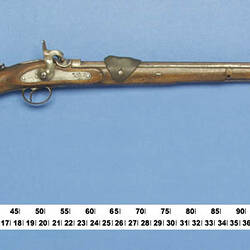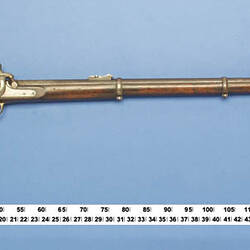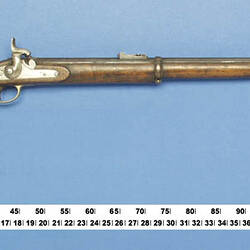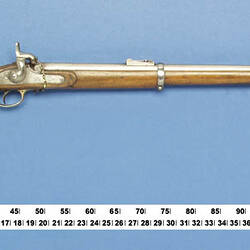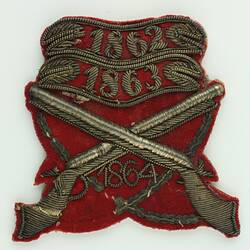Summary
British Service percussion rifle, Pattern 1853 Rifle, third model, cal. .577 in., steel rifled round barrel, cut down to 661 mm long. Made by government contractors in Birmingham, and with Tower markings, 1860.
Buttplate tang stamped 'D/ 543/ V.V' denoting use by the Victorian Volunteer forces.
One of 26 guns donated in 1871 by the Victorian Ordnance Department from its Melbourne Armoury, for the newly created Industrial and Technological Museum. The display was intended to show mechanics and gunsmiths the principles of gun construction and recent technical developments in weapons.
Physical Description
Steel lock and hammer on R.H. side, brass oval triggerguard with small front spur, no sideplate, brass butt plate, one sling swivel, one missing from triggerguard. Front sight missing due to barrel shortening, graduated rear sight, barrel fastened to stock via two steel barrel bands, steel ramrod missing. Lockplate stamped with crown over 'VR' and '1860/ TOWER', denoting year of manufacture, and small crown over broad arrow. Stock is stamped on R.H.side in a circular frame 'BIRMINGHAM/ 1860' and crown over a downward pointing government broad arrow with the initials 'W' and 'O' either side, stamped '1' to the R. of previous stamping. Stamped 'KING & PHILLIPS' under stock, and inside barrel groove above 'J.JORDAN'. Underside of barrel stamped 'J.TURNER' and assorted proofing marks. Barrel tang stamped with two crowns and barrel L.H.side stamped with crown over 'TP' and examiner marks. Buttplate tang stamped 'D/ 543/ V.V' denoting use by the Victorian Volunteer forces.
Significance
The Pattern 1853 Rifle, often called the 1853 Enfield because of its use of Enfield rifling, was a significant step in the development of British military longarms, being a major departure from what had come before it by fastening the barrel to the stock via the use of barrel bands, rather than pins as had been the norm previously, and for the use of a rifled barrel. The Pattern was produced in three distinct models, the third - produced between 1858 and 1863 by a large number of London and Birmingham contractors - being the most common. Large numbers were also produced in Belgium and America. The second model, illustrated by this record, differed from the third model by having its three barrel bands being made solid and fastened to the stock via inlet springs. The third model had hinged bands that were fastened by a bolt underneath the stock.
More Information
-
Collecting Areas
-
Acquisition Information
Donation from Melbourne Armoury, 24 Oct 1871
-
Place & Date Made
-
User
Victoria: Ordnance Branch, Melbourne, Greater Melbourne, Victoria, Australia, 1860-1871
-
Inscriptions
Stamped on barrel L.H.side: crown over TP (Tower Proof) and 18 over B (examiners mark) Stamped on barrel tang with two crowns Stamped on barrel underside: TURNER Stamped on barrel underside: J. TURNER Stamped on barrel underside: 17 over Illegible.mark; three zig zag strokes; B over 46 and B over 18 (Birmingham mark);T.T; VW Stamped on butt tang: D/ 543/ V.V Stamped on lockplate: crown over VR; 1860/ TOWER Stamped on stock underside: KING & PHILLIPS Stamped on stock R.H.side in circular frame: BIRMINGHAM/ 1860, crown over broad arrow with flanking initials 'W' and 'O' Stamped on stock R.H.side: 1
-
Model Name or Number
-
Brand Names
-
Classification
-
Category
-
Discipline
-
Type of item
-
Overall Dimensions
107.3 cm (Length), 5.2 cm (Width), 21 cm (Height)
Barrel length: 66.10cm (cut-down)
-
Keywords
Rifles & Muskets: British, Rifles & Muskets: Military, Victorian Colonial Defence Forces, Victorian Volunteer Forces





